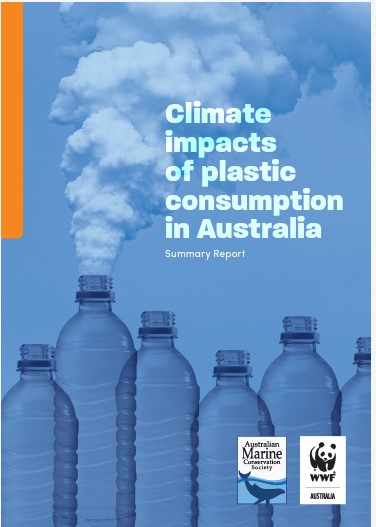New research shows the plastics Australians consume in one year produce as much greenhouse gas as 5.7 million cars on our roads annually and Australia’s plastic emissions will more than double by 2050 if we continue on our current path.

From WWF Australia and Australian Marine Conservation Society
Recycling alone won’t solve this problem – we must cut plastic use and stop using virgin plastic made from fossil fuels.
We can cut plastic emissions by up to 70% by cutting plastic use by just 10%, improving recycling rates and using renewable energy.
The plastic consumed in Australia in just one year produces more greenhouse gas emissions than one third of our car fleet creates annually, according to groundbreaking research into the climate costs of Australia’s plastic addiction.
The report, produced by environmental consultants Blue Environment for the Australian Marine Conservation Society and WWF-Australia, shows that in 2020 Australia’s emissions from plastics created more than 16 million metric tonnes of greenhouse gases – equivalent to the emissions produced by 5.7 million cars on Australia’s roads annually.
If we continue on our current path of accelerating plastic consumption, the emissions from Australia’s plastics will more than double to 42.5 million tonnes annually by 2050 – the year Australia has legislated to reach net-zero emissions.
The Center for International Environmental Law estimates plastics could account for up to 15% of the world’s carbon budget by 2050 if decisive action is not taken.
The report, Carbon emissions assessment of Australian plastics consumption, is the first major study to model the emissions associated with the production and disposal of plastics, including recycling, and what Australia can do to cut those emissions.
The report shows that plastics produce significant emissions, and virgin plastics made from fossil fuels were the most emissions intensive to produce, creating more than double the emissions of any other plastic.
In Australia, we generate more single-use plastic waste per person than any other country except Singapore. The good news is that we can cut plastic consumption by 30% by 2040 through such approaches as banning plastic or increasing the use of reusables, before needing to substitute plastics with other materials.
AMCS Plastics Campaign Manager Shane Cucow said: “The findings are shockingly clear. We already knew runaway plastic use is creating mountains of waste and pollution, killing millions of animals every year through entanglement or ingestion. Now we have clear evidence it is also fuelling global warming, which is endangering our entire marine ecosystem.
“We must use less plastic, stop using fossil fuels to make it, and stop using fossil fuels as an energy source for plastic production and recycling. If we don’t, the emissions from plastic will only increase and exacerbate climate change.”
WWF-Australia No Plastics in Nature Policy Manager Kate Noble said: “We can’t rely on recycling solely to get us out of this mess; we need to drastically cut our plastic use and stop using virgin plastic made from fossil fuels. Even if we recycle 100% of the plastic we use, we’ll still see emissions double to more than 34 million tonnes annually by 2050.
“The good news is that we can reduce plastic waste and cut down the emissions from plastic at the same time. Reducing plastic consumption, combined with better design, using it longer, and managing it more responsibly, is the only way to bring our plastic addiction under control, and reduce the climate impacts of plastics at the same time.”
Cutting plastics emissions
The report modelled various scenarios including reducing plastics use, decoupling plastic production from fossil fuels, decarbonising energy systems globally, and significantly increasing recycling rates. Simply capping plastic production at current levels results in nearly a 40% fall in carbon emissions by 2050 relative to business as usual.
Scenarios that solely rely on increasing recycling rates perform only marginally better than business as usual. Scenarios using renewable energy perform moderately well, and this is a key contributor to the combined scenarios that achieve high reductions in carbon emissions relative to BAU.
Overall, the study findings strongly indicate that multiple complementary system level changes are required to significantly reduce the carbon emissions relating to plastics use.
Under a combined scenario, Australia could reduce the total emissions from its plastic use by up to 70% by 2050, with the greatest impact achieved by cutting plastics consumption by just 10%. We would need to:
use plastics more efficiently and cut total consumption by at least 10%,
rapidly increase plastic recovery and recycling to 100%,
fully power plastics production and recycling with 100% renewable energy, and
move away from virgin fossil-fuel based plastic entirely.
While these are ambitious goals that Australia is not currently equipped to meet, the report highlights the need for strong action on plastic consumption and waste management now, to avoid the growing waste, pollution and climate costs caused by skyrocketing plastic consumption.
The research also found:
Greenhouse gas emissions from plastic production are higher than previously thought, due to substantive new research that indicates that methane from gas extraction and processing is at least 25-40% higher than estimates used by governments globally, which has been averaged to 32.5% for this report. This is likely to be an underestimate, with recent figures from the International Energy Agency putting the discrepancy at 70% higher than former estimates.
Manufacturing virgin fossil-fuel based plastics produces on average 3,490kg CO2e per tonne, more than double the emissions of producing new plastics through mechanical recycling (1,610kg CO2e/t) – 2.2 times the global warming potential (GWP) over GWP 20 years.
Fossil-fuel based plastics produce nearly three times the emissions to manufacture than plant-based plastics (1,280kg CO2e/t –2.7 times over GWP 20-year basis)
Incineration and burning plastics to produce energy are the most emissions intensive disposable methods for plastics.
Chemical recycling of plastics – where plastic waste is chemically treated to produce oil that can be used as fuel or remanufactured into plastic – is more emissions intensive than mechanical recycling, producing 67% more emissions than mechanical recycling.
Note: The emissions reduction scenarios modelled only refer to plastic emissions and do not consider the emissions of substituted products or other environmental harms caused by plastics. They are indicative projections only and further work is needed to identify technical pathways for reducing plastics consumption and increasing recovery.


